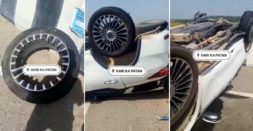The Delhi-Mumbai Expressway, particularly the Gurgaon-Dausa section in Rajasthan, has become an adrenaline-fueled playground for luxury car enthusiasts. It’s a spectacle that involves Ferraris, Porsches, BMWs, and Mercs zooming down the road at breakneck speeds, effortlessly breaching the 200 Kmph mark, with some daredevils even hitting a jaw-dropping 260 Kmph.
These supercars, usually tucked away in garages or making fleeting appearances on the region’s quieter roads at night, have discovered a new frontier to flaunt their horsepower. However, the thrill comes at a grave cost as these speedsters consistently defy the prescribed speed limits meant for ensuring road safety. The Delhi-Mumbai Expressway, a high-speed corridor connecting major cities, has a maximum speed limit of 120 Kmph.
Also read: 10 DC Design cars & how they look in the REAL world: Maruti Swift to Mahindra XUV500
Shockingly, it has now turned into a battleground where speed demons play a dangerous game. The Vehicle Speed Detection System (VSDS) installed on the expressway reveals a harrowing truth – the daily average of luxury cars flouting speed limits is a staggering 500, despite an average of around 20,000 vehicles using the expressway daily. The data, however, is only limited to the portion of the expressway in Gurgaon, so the actual number of violations is likely much higher.
The consequences of this high-speed menace are undeniable. Over the last two months, the expressway witnessed two horrific accidents involving speeding supercars – a Rolls-Royce and a Mercedes – both racing at over 200kmph. These crashes resulted in the tragic loss of three lives. Recognizing the gravity of the situation, the National Highways Authority of India (NHAI) took action. In an effort to curb reckless speeding, they installed VSDS and Automatic Number Plate Recognition (ANPR) cameras along the Gurgaon section of the expressway. These cameras capture footage of violators, especially those in high-end cars like Ferraris, BMWs, Rolls-Royces, Porsches, and Mercedes, clocking speeds of 200-260kmph.
NHAI’s Project Director, Mukesh Kumar Meena, stressed the importance of integrating VSDS with traffic police’s systems. While NHAI manages the expressway, it lacks the authority to penalize erring motorists. Instead, they collect data from the camera network and share it with the police for necessary action. DCP (Traffic) Gurgaon, Virender Vij, affirmed the practicality of using cameras to enforce traffic norms. He argued that deploying officers on a high-speed corridor wasn’t safe, and cameras provide a safer and more efficient means of detection and punishment.
The Delhi-Mumbai Expressway, opened earlier this year, spans 246 Km from Sohna in Gurgaon to Dausa in Rajasthan. This eight-lane expressway connects major metropolises and has brought convenience to commuters. However, the need for stringent enforcement of speed limits and safe driving practices cannot be emphasized enough to prevent further tragedies on this high-speed corridor.
Also read: Upcoming 2022 Maruti Suzuki Vitara Brezza rendered






![73 year-old MG car from India finally reaches England covering 11,000 km [Video]](https://www.cartoq.com/wp-content/uploads/2023/11/mg-vintage-car-road-trip-featured-253x131.jpg)



![Multiple Roads And Underpasses In Delhi Waterlogged After Heavy Rains [Video]](https://www.cartoq.com/wp-content/uploads/2024/06/delhi-under-water-logging-floods-cars-stuck-253x131.jpg)